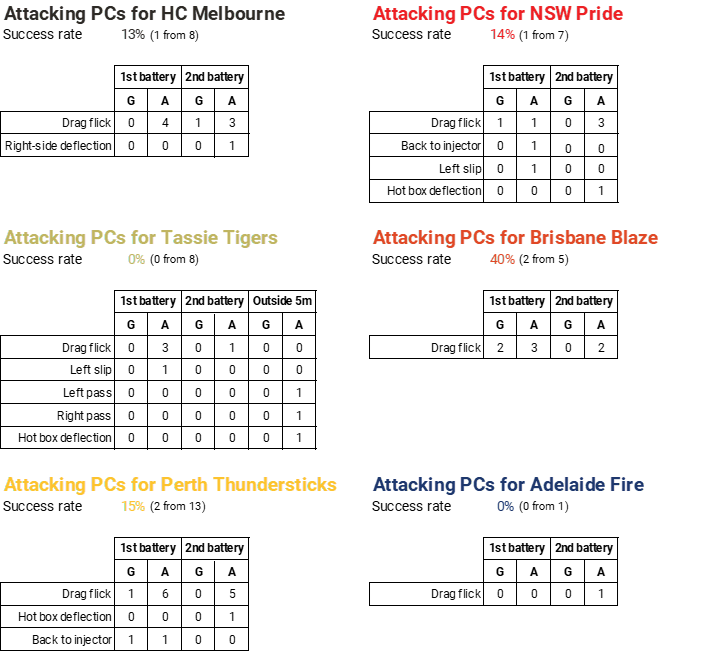Conversions and PCs
The field goal conversion rule is a non-standard field hockey rule being used in the Hockey One League 2022. The rule means that when a field goal or penalty stroke is scored, time is stopped and the scorer has a one-on-one shootout with the goalkeeper for the chance of an extra goal. The rule was designed to create an incentive to score field goals over penalty corner (PC) goals.
Conversions create an interesting option for teams during attacking PCs. If a ball travels more than 5 metres outside the circle, the PC phase is over and a goal would be deemed a field goal (with a conversion opportunity). During Round 1 of the Hockey One League, most teams adopted the standard first and second batteries at the top of the ‘D’, with one player to the left and 1-2 players to the right (see Figure 1). Perth Thundersticks were a notable exception, explicitly threatening a field goal variation during their attacking PCs by placing two players on the dashed outer 5 metre circle in their Round 1 clash with Adelaide Fire.
Figure 1: Set up for attacking PCs in Round 1 (M) of the Hockey One League 2022.
Approximate player positions based on observations from several PCs.
Ultimately, the Thundersticks did not use a field goal variation in their 13 PCs against the Fire but this type of variation was used during the round. Tassie Tigers were forced to use several field goal variations as they chased the game against Brisbane Blaze. While they were not able to score, the Tigers were able to create shots on target from these variations.
Despite the conversion rule, teams placed a strong emphasis on securing PCs and the perceived reliability of the drag flick. There were 42 PCs during Round 1, with the drag flick option pursued 32 times (see Figure 2). Five goals were scored from drag flicks.
Figure 2: Attacking PC variations used during Round 1 of the Hockey One League (Men).
G: Goal, A: Attempt. 1st battery (aka castle) is positioned to the left for an attacking team facing the goal.
Yet, there is no denying the value created by field goals. During Round 1, the overall success rate on conversions was about 67%, which is higher than the conversion rate of 49% for the competition in 2019. These figures suggest field goals have an expected value of 1.5-1.7. While this would seem to favour the pursuit of field goals, field goal opportunities are difficult to create. There were just 17 field goal shots on target from 133 circle entries during Round 1. Attacking PCs may be one avenue where teams can improve their chances of scoring field goals.
Round 1 has shown divergent strategies from teams in response to the conversion rule in attacking PCs. It is still too early to determine which tactics will prove most effective. The forthcoming rounds will reveal which teams have got the emphasis right and which teams need to revisit their approach. Bring on Round 2!


